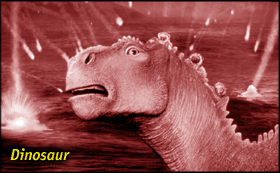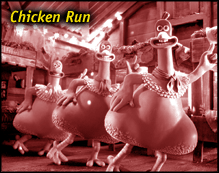![[Sidebar]](/standard/image/sidebar.gif)
July 21 - 28, 2000
![[Movie Reviews]](/standard/image/headers/movie_reviews_header.gif)
| reviews & features | by movie | by theater | film specials | hot links |
|
|
|
Suspended animation
Is the computer-generated film becoming Hollywood's dinosaur?
by Peter Keough

Animation may have a lot of life in it yet, but you could hardly tell from Dinosaur. This extravagantly hyped and merchandised -- and all-too-appropriately titled -- Disney film, which used the latest computer technology in its story of three-dimensional talking saurians and lemurs, is rumored to have cost $220 million. To date it's made back
barely half that, which means it's one of the year's biggest flops. Neither does Titan A.E. bode well for the future of the form. Don Bluth's expensive, uneven remake of Star Wars is a cheery tale about the plight of the human race after the destruction of planet Earth. With a box office thus far of about $22 million,Titan can look to make a profit sometime A.E. As for Fantasia 2000, if you're looking for the cutting edge in innovativeness and creativity, I'd suggest you look back to Fantasia 1940.
When they were released, in short order at the beginning of the summer, these three films were seen as evidence that the Toons were finally taking over Hollywood. Since the late '80s, animation has been surging in prestige and commercial clout, and there's been a deluge of high-profile animated releases over the past decade. Disney applied its traditional mix of song, dance, and shtick to classic tales from myth, literature, and history, beginning in 1989 with The Little Mermaid and continuing with Beauty and the Beast (1991), Aladdin (1992), The Lion King (1994), Pocahontas (1995), The Hunchback of Notre Dame (1996), Hercules (1997), Mulan (1998), and Tarzan (1999), the last of these demonstrating further refinements in digital technology. Disney has also laid claim to the new CGI (computer-graphic imaging) technology with Toy Story (1995), A Bug's Life (1998), and Toy Story 2 (1999).
Not to be outdone, the new megastudio DreamWorks turned out its own CGI production, Antz (1998), and followed up later the same year with its own Disney-style epic, The Prince of Egypt. At the other extreme of taste, sensibility, and technique (or lack thereof) was Paramount's subversive South Park (1999), an adaptation of the taboo-breaking TV series that despite, or because of, its tastelessness garnered critical acclaim, made lots of money, and even earned an Oscar nomination.
The money was rolling in, the technology was progressing exponentially, and it seemed that a new era in cinema, not just animation, was dawning. Then, like the hapless dominant species in Dinosaur and Titan A.E., the genre was blindsided by disaster.
True, not all the animation entries failed dismally. Nick Park & Peter Lord's Chicken Run proved an exception, receiving critical accolades (lukewarm from me) and earning grosses ($77 million so far) that may eventually rival those of Dinosaur. The film that isn't afraid to get its hands dirty turns out to be not an overdigitalized synthetic product from a major Hollywood studio but a standard stop-action piece of claymation made by a small British outfit, Aardman Animations.
So what is it that a mucky coop of plasticine poultry has over the expensively re-created wasteland of Dinosaur and the breathtaking alien landscapes of Titan? Characters and a story, to begin with. Also humor, some of it derived from the physical gags of the silent-comedy tradition, some from the dry absurdity of Monty Python. Then there's the telling detail (Mel Gibson shows a greater range of facial expressions as a clay rooster than in almost any other role), the subtlety of allusion (the film is a mini-history of the prison-escape genre, including Jean Renoir's Grand Illusion), and the ironic depth beneath the surface childishness.
And though it doesn't come up to brilliant Aardman shorts like "Creature Comforts" and the Wallace & Gromit series, Chicken Run allows the viewer room to dwell among its whimsical creations. It's not overstuffed with verisimilitude, sentimentality, clichés, and a bad soundtrack. Despite its sophistication (and even its oversophistication), Chicken Run is basically a matter of overgrown kids playing with clay to tell a story, and not necessarily a pleasant or enlightening one. Had it been more perverse and darker (in spirit, not in set design -- its drabness is a drawback), it would have touched on the same anarchic nerve as South Park. Certainly its insistence on expressive freedom over slavish realism is more akin to the animated graffiti of South Park than to the lumbering trompe l'oeil monstrosities of Dinosaur.
Like most advances, the new computer technology has been a mixed blessing. It offers more opportunities and greater freedoms but also greater temptations. Its power to create and manipulate the illusion of reality is unprecedented; the danger is that this realism will, as in non-animated movies, leave no room for the imagination.
I'm reminded of a scene at the beginning of the animated classic that may well have ushered in the renaissance of the past decade, Robert Zemeckis's Who Framed Roger Rabbit (1988 and made, before the advent of digital technology, the old-fashioned optical way). The film opens with a zany cartoon in the frantic laws-of-physics-defying style of Tex Avery or Chuck Jones and then cuts to the Hollywood set on which it's shot. The real-life devices by which the studio re-creates the cartoon universe are almost more absurd and hilarious than the cartoon itself.
What animators these days are doing is exactly the opposite: they're using their cartoon art to re-create reality. What distinguishes the animation in Dinosaur from the effects in The Patriot or Gladiator? In both the struggle to eliminate the seam between the fake and the real merely emphasizes the fakery of the whole process. Blurring this line may be a technological feat, but what matters to the viewer is the transition from real to imagined, the moment when the humdrum world is transformed, for example, into a pas de deux with Fred and Ginger, or the surfacing of the shark in Jaws, or the hair gel on Ben Stiller's ear in Something About Mary. Film, especially animated film, serves as a gateway between the everyday and the magical, a transition epitomized in Who Framed Roger Rabbit when Bob Hoskins drives down the tunnel and the dreary Chinatown-ish world of 1940s film noir Los Angeles gives way to the figment-filled free fall of Toon Town.
Animation shouldn't try to mirror the world outside -- it should try to tap into the world within. Its artifice of innocence provides a safe medium for relaxing taboos and unleashing the repressed, as in South Park, or indulging in childish wonder, as in A Bug's Life. It combines satire, self-referentiality, and a willing suspension of irony. In Antz, for example, we can laugh at Woody Allen's sophisticated shtick even as we marvel at an ant's-eye view of being stuck in a wad of gum on a tennis shoe.
Animation features have been able to take on themes that more "serious" genres would shrink from. Extinction is a prominent idea in Dinosaur and Titan A.E., and it makes a curtain call in the "Firebird Suite" coda to Fantasia 2000. Genocide flickers behind the fun in this year's The Road to El Dorado and Chicken Run. Feminism turns up in The Little Mermaid, Pocahontas, and Mulan, divine will in The Prince of Egypt, the twilight of the gods in Hercules, civilization and its discontents in Antz and Tarzan, and the military industrial complex in Small Soldiers (1998) and The Iron Giant (1999).

So it's no surprise that many serious actors seem more drawn to animation than to special-effects-laden real-life films. No doubt the prospect of getting a pay check for a couple of weeks' work in front of a microphone (with no long hours in make-up, no lines to memorize, and rarely a bad review from the critics) is attractive, but I think the real appeal is that whereas special effects tend to smother a performance, animation can amplify it, exaggerating traits into caricature but also capturing the elusive essence of a characterization. Mel Gibson is more interesting as the fowl in Chicken Run than as the half-baked ham in The Patriot. Robin Williams and Woody Allen put in some of their best work in Aladdin and Antz; Tom Hanks as cowboy Woody in the Toy Story movies comes across as more human than he does as the flesh-and-blood hero lost in the special-effects firestorm of Saving Private Ryan.
Of late, such performances have been in decline -- and the emphasis on state of the art as opposed to mere art is responsible. In The Prince of Egypt, the parting of the Red Sea lived up to its billing, but Ralph Fiennes's Moses seemed more like a modern-day studio executive than a Biblical patriarch -- a cell phone would have served better than a Burning Bush. Matt Damon won't win any Oscar nominations for his part in Titan A.E., though the film might get a nod for its mind-boggling designs of the planets of bat people and sulfurous gas bubbles. And can you really tell one iguanodon from another in Dinosaur, or for that matter remember any of the hens in Chicken Run?
Disparaging the advances in animation is futile, of course -- had such thinking prevailed, we'd still be watching silent movies. The challenge, as always, is to harness the new tools to the imagination. Andy Knight, perhaps a better film pundit than a filmmaker (Beauty and the Beast: The Enchanted Christmas), wrote recently that if the new technology "were compared to a painting, we have seen Michelangelo, but we have yet to see Picasso, Klee, or Goya." In lieu of Picasso, Klee, or Goya, perhaps we can take encourage such maverick filmmakers as Jan Svankmajer and the Brothers Quay to incorporate their eccentric visions into mainstream fare. And there's always Tim Burton, whose 1993 animated brainchild The Nightmare Before Christmas might have failed but whose borderline sensibility seems to have infected some of the more vivid elements of recent animation -- the freak toys of the weird kid next door in Toy Story were in my opinion the best part of the movie.
The good news, in fact, is that the next major projects seem to be taking a Tim Burtonish if not Goya-esque turn. The Disney people who brought us Toy Story are now working on Monsters, Inc., in which creatures pass, Being John Malkovich-style, through portals to places under little girls' beds. And the DreamWorks folks behind Antz are bringing out Shrek, which is based on the William Steig children's story about an ogre courting an ogress, with Mike Myers, Cameron Diaz, and Eddie Murphy providing the voices. Now that the dinosaurs are out of the way, maybe the next phase in the evolution of animation will emerge.